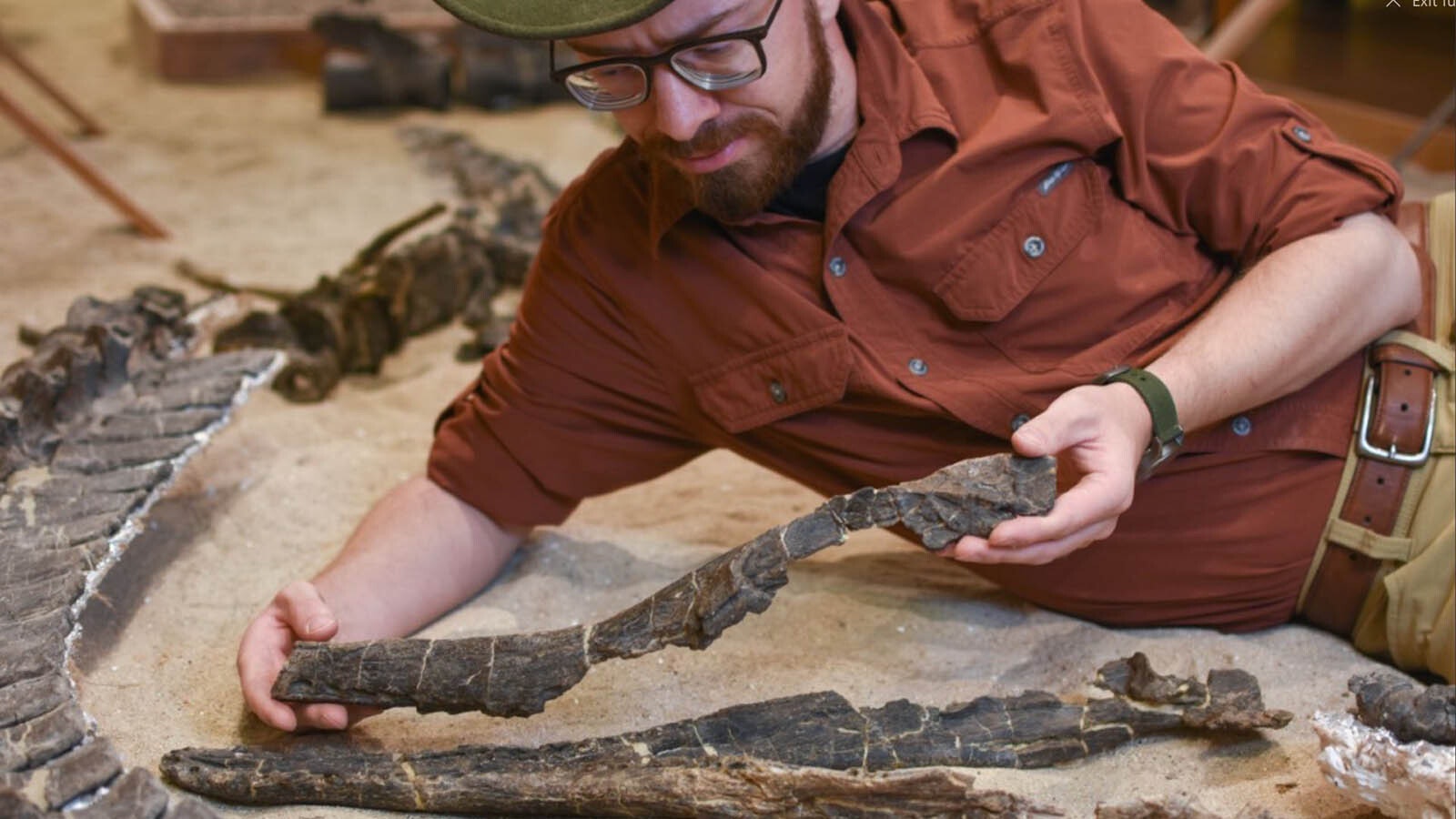By Wendy Corr, Cowboy State Daily
wendy@cowboystatedaily.com
Serpentisuchops pfisterae is the scientific name for the remarkably intact, 7-meter-long fossil that was found in 1995 and has been at the Paleon Museum in Glenrock for the last 15 years.
But locals just call him “Harold.”
And just this week, Harold’s place in history was set with the publishing of a scientific paper identifying the fossil as a one-of-a-kind polycotylid plesiosaur from the Cretaceous period of about 101 million to 66 million years ago.
The paleontologist who published the paper, Dr. Scott Persons, told Cowboy State Daily he’s not surprised that Harold is drawing national attention.
“It’s a really, really cool animal,” said Persons. “It’s got a fun appearance to it, and it has this neat evolutionary story to tell.”

Harold and the Glenrock Bone Biddies
In 1995, landowner Anna Pfister contacted the Paleon Museum in Glenrock about a fossil discovered on her land.
“The Pfister family owned the land where the specimen was found,” said Persons. “And rather than making the decision to try to sell the animal at auction or something like that, she decided to donate it to be studied by science and to go on display for the children of Wyoming.”
Don Smith, executive director of the museum, said Pfister dug the fossil out of the ground herself before bringing it in.
“She actually had it all jacketed up in a field jacket, and she walked through the door wanting to keep Wyoming dinosaurs in Wyoming,” said Smith. “And we got to know her, and she has entrusted us with what turns out to be one of a kind.”
According to Persons, who has studied the unique plesiosaur at the Paleon Museum since childhood, a group of volunteers at the museum did the delicate work of cleaning up the fossil for the display.
“The folks that did the work preparing the specimen, cleaning it up, really chiseling away all the rock that was still encrusted around the bones, that was done by the volunteer team at the Paleon Museum,” he said. “And that team largely consists of a group of elderly ladies from the Glenrock community that are affectionately referred to as the ‘Glenrock Bone Biddies.’”

The Paleon Connection
Since he was a young boy, Persons has been fascinated by dinosaurs. When he was in elementary school, his parents allowed him to take a trip to Wyoming for his first fossil hunt.
“The Glenrock Paleon Museum at the time – and they still do – offer the opportunities for families to contact them and to arrange to be taken out on some of the local digs,” said Persons. “It’s where I went on my very first dinosaur hunting expedition. It’s where I found my first chunk of dinosaur bone, and that was way back when I was in elementary school.”
Although he’s known about the uniqueness of the Glenrock plesiosaur, only in the last few years has he had the personal resources and connections to introduce Harold to the rest of the world.
“The challenge with Harold has been getting the specimen to the stage of preparation that it can be scientifically studied – that it can be photographed, that measurements can be taken,” said Persons, who is a professor at the College of Charleston in South Carolina. “And it’s taken a while for me to get to a position where I’m free to pursue my own research interests and to start up my own research program.”
On Sept. 26, the journal iScience published the details of the Serpentisuchops Pfisterae (which Persons said means “serpentine crocodile face,” with the second part of the name a nod to the landowner, Anna Pfister) – and since then, the Paleon Museum has seen a little more activity.
“Last Thursday, we had zero visitors in,” Smith said. “Just this morning, we had seven visitors. We had several in here from Glenrock and Casper that had heard about the find and they showed up to see it.”
What Makes Harold Special
Persons said that the Paleon Museum’s specimen is quite different from other plesiosaurs that have been found in the area.
“It’s got this incredible series of perfectly articulated neck vertebrae,” said Persons. “The bones in the animal’s neck are laid out just as they would have been in life, they’re not all a jumble, they’re not out of position. And of course, the animal also has a beautiful lower jaw that shows off this long, crocodile-like form, and that really is strange.”
Persons said traditionally, plesiosaurs have been divided into specimens that have short necks and long, crocodile-like snouts; and those with small heads, short jaws and long necks.
“And Harold just straddles both of those categories,” said Persons. “And it defies traditional classification.”

More In Store For the Paleon
Smith said the number of visitors to the Paleon Museum have been down this year so far, but that might change with the attention Persons is bringing to the small-town natural history museum.
“Just this year alone, we’ve probably had 2,500 different visitors in here,” said Smith. “I’ve had them in here from 14 different countries, and I get to visit with people from literally every state in the union.”
And Persons said the Paleon has more stars in its collection than just the unique plesiosaur. In fact, he’s taking a group of his students to the Geological Society of America’s annual conference in Denver, at which they will present several specimens from the Glenrock museum.
“We will be presenting on the wing of a pterosaur that was found at the same spot (as Harold),” he said. “We will be presenting on some of the horned dinosaur material that’s dug up right there in Glenrock. We will be presenting on a pterosaur trackway. And we will be presenting on a beautiful, beautiful prehistoric turtle shell.”
But a detour to tiny Glenrock, Wyoming, is the only way to see for yourself the one-of-a-kind dinosaur fossil found and dug up by a landowner, and cared for by the Bone Biddies.





